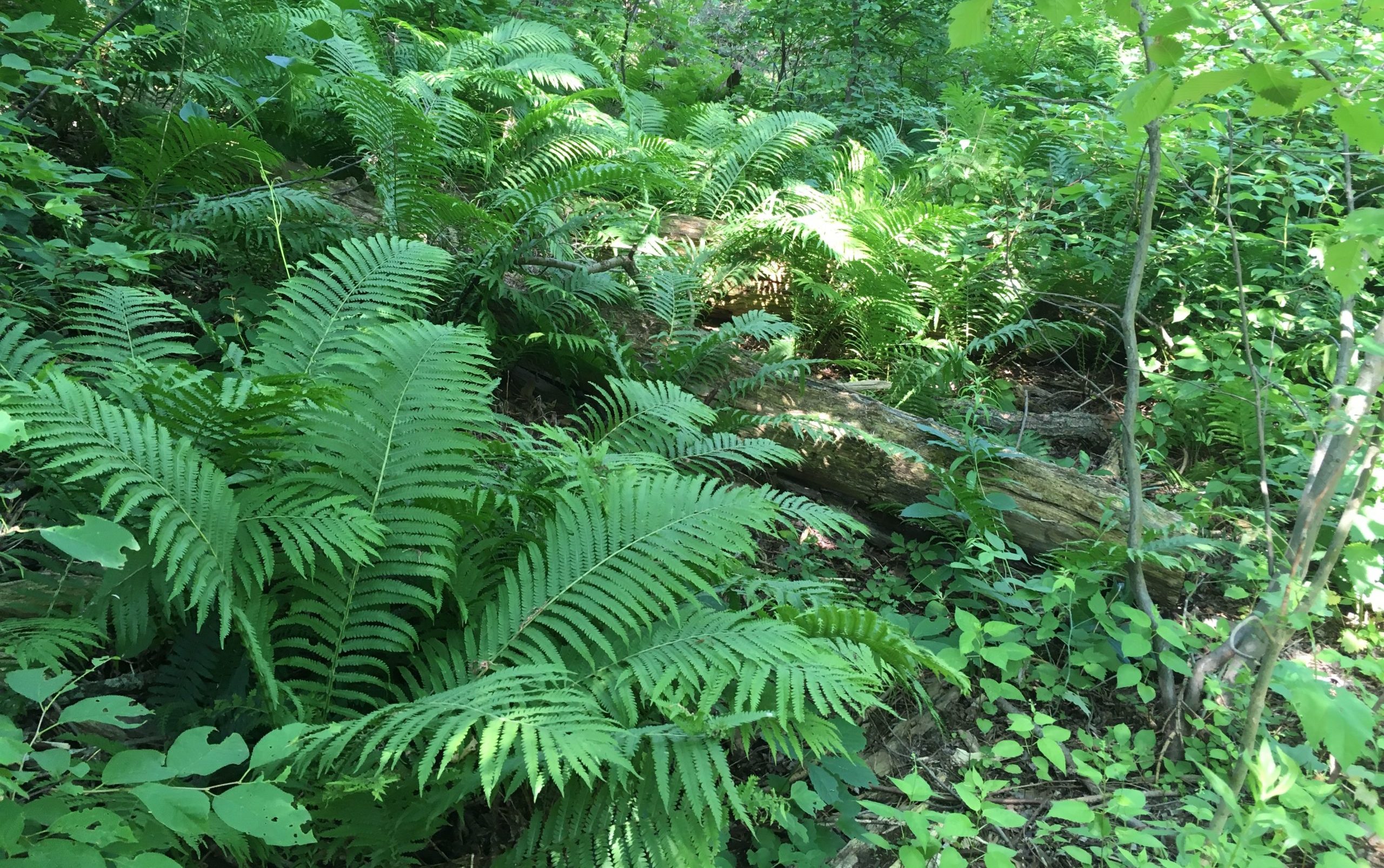History of Toronto’s ravines
Just north of Toronto, the Oak Ridges Moraine, marks the start of Toronto’s impressive ravine system that extends down to the shoreline of Lake Ontario.1 Our ravines:
- were created 11,000 years ago when glaciers receded north, creating river valleys as they went along.2
- were once used as trade routes through traditional lands of the Huron-Wendat, Seneca, Anishinabeg, Chippewa, Haudenosaunee, and Missisaugas of the Credit River.3
- consist of three main river systems: the Rouge, the Don, and the Humber, as well as other small creeks like Mimico, Highland and Taylor Creek.4
- have an intricate network of smaller streams and creeks, soil, geology, flora, and fauna that work together to create a dynamic ravine environment.5
In the 19th and early 20th centuries, we did not appreciate our ravines as we do now. Ravine land was often considered messy, unattractive, and disorderly which meant that many areas were built over, filled in, or used as dumping grounds.6
However, this perspective shifted in 1954 when Hurricane Hazel hit the city; 30 million tons of water fell, 81 people were killed, and countless families and homes were destroyed forever.7 In wake of this disaster, the province realized the importance of our ravine system for storm water management and flood control, and most ravine land was legally protected from development.8
Since then, organizations like Toronto and Region Conservation Authority and Task Force to Bring Back the Don have focused on cleaning up from our ecological naiveté by protecting and restoring our ravines.9 Many important measures have been taken to help our ravines over the years, such as our Ravine and Natural Feature Protection Bylaw adopted in 2002.10 The City has committed to improving the ecological health of our urban forest with The Toronto Ravine Strategy, Ravine Strategy Implementation Plan, The Biodiversity Strategy for Toronto, and the Toronto Pollinator Protection Strategy.
Toronto’s ravines – our unique identity
There is no denying that the Toronto ravines are magnificent. As the most populous city in Canada, our ravines provide natural green spaces for all Torontonians and connect a diverse group of cultures and communities.11 No other major city in the world has such a vast urban forest linked by intricate networks of rivers and streams.12
- We are used to experiencing nature all around us – most of us live within walking distance of a ravine.
- The presence of this vast ravine system throughout the city– even the remnants in our downtown core – defines our city, much like the canals of Venice or Amsterdam and the hills of San Francisco.13
Toronto ravines are undeniably unique due to their sheer size and spread, making us one of Canada’s greenest megacities. Our ravines are:14
- 17% of the City’s land area
- 11,000 hectares protected under The Ravine and Natural Feature Protection Bylaw
- 60% publicly owned and 40% privately owned with 30,000 private addresses
- Supporting 369 different bird species15 and 82 different fish species16 found in Toronto’s watercourses and adjacent Lake Ontario.
Our dynamic ravines form the backbone of Toronto. However, to keep ravines healthy, we must all take responsibility and care for them. As a private ravine landowner, you are in a unique position to make a difference. Your ravine stewardship will have a large impact on both current and future generations.
Footnotes
1 – City of Toronto. (2017).Toronto ravine strategy. Retrieved from: https://www.toronto.ca/wp-content/uploads/2017/10/9183-TorontoRavineStrategy.pdf
2 – City of Toronto. (2017).Toronto ravine strategy. Retrieved from: https://www.toronto.ca/wp-content/uploads/2017/10/9183-TorontoRavineStrategy.pdf
3 – Toronto City Planning Parks, Forestry, and Recreation with the Toronto and Region Conservation Authority. (2019). Wild, connected, and diverse: a biodiversity strategy for Toronto. Retrieved from: https://www.toronto.ca/legdocs/mmis/2019/ie/bgrd/backgroundfile-136906.pdf
4 – City of Toronto. (2017).Toronto ravine strategy. Retrieved from: https://www.toronto.ca/wp-content/uploads/2017/10/9183-TorontoRavineStrategy.pdf
5 – City of Toronto. (2017).Toronto ravine strategy. Retrieved from: https://www.toronto.ca/wp-content/uploads/2017/10/9183-TorontoRavineStrategy.pdf
6 – Bonnell, J. L. (2014). Reclaiming the Don: an environmental history of Toronto’s Don river valley. University of Toronto Press.
7 – City of Toronto. (2017).Toronto ravine strategy. Retrieved from: https://www.toronto.ca/wp-content/uploads/2017/10/9183-TorontoRavineStrategy.pdf
8 – City of Toronto. (2017).Toronto ravine strategy. Retrieved from: https://www.toronto.ca/wp-content/uploads/2017/10/9183-TorontoRavineStrategy.pdf
9 – City of Toronto. (2017).Toronto ravine strategy. Retrieved from: https://www.toronto.ca/wp-content/uploads/2017/10/9183-TorontoRavineStrategy.pdf
10 – Toronto Municipal Code. (2016). Chapter 658, Ravine and natural feature protection. Retrieved from: https://www.toronto.ca/legdocs/municode/1184_658.pdf
11 – City of Toronto. (n.d.). A property owners guide to healthy ravines. Retrieved from: https://www.toronto.ca/data/parks/pdf/property-owners-guide-to-healthy-ravines.pdf
12 – Cecco, L. (2018). “There’s no major city like it”: Toronto’s unique ravine system under threat. Retrieved from: https://www.theguardian.com/cities/2018/dec/21/theres-no-major-city-like-it-toronto-unique-ravine-system-under-threat
13 – Fulford, R. (1995). Accidental city: the transformation of Toronto (1st ed.). Macfarlane Walter & Ross.
14 – City of Toronto. (2017).Toronto ravine strategy. Retrieved from: https://www.toronto.ca/wp-content/uploads/2017/10/9183-TorontoRavineStrategy.pdf
15- City of Toronto. (2018). Birds of Toronto: a guide to their remarkable world. Retrieved from: https://www.toronto.ca/wp-content/uploads/2020/05/8ea3-City-Planning-Birds-of-Toronto-Biodiversity-Series.pdf
16– City of Toronto. (2012). Fishes of Toronto: a guide to their remarkable world. Retrieved from: https://www.toronto.ca/wp-content/uploads/2017/08/971b-Biodiversity-FishesBook-Division-Planning-And-Development-part1.pdf
For more history refer to:
- Toronto’s Ravines and Urban Forests: Their natural heritage and local history by Jason Ramsay-Brown (2020)
- An Enduring Wilderness: Toronto’s Natural Parklands by Robert Burley (2017)
- The Once and Future Great Lakes Country: An Ecological History by John L. Riley (2014)

